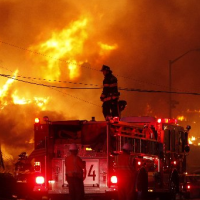Ex-PG&E Specialist Claims Utility Misused His Data to Mislead Regulators
 San Bruno fire after a gas line exploded (photo: Brant Ward, San Francisco Chronicle)
San Bruno fire after a gas line exploded (photo: Brant Ward, San Francisco Chronicle)
The Pacific Gas & Electric Company relies on a sophisticated computer database to provide a map of its gas pipeline system for safety and maintenance purposes. The “incomplete and inaccurate pipeline information” it generated prompted federal investigators of the deadly 2010 San Bruno pipeline blast to conclude it was a contributing cause of the blast.
Christopher Surbey, an ex-PG&E specialist who claims he was hired to help fix the database system in 2011, is suing his former employer for firing him later in the year. The lawsuit, according to Courthouse News Service, alleges PG&E retaliated against Surbey for accusing the company of tricking regulators into granting rate increases to pay for database system upgrades it wasn’t going to make.
The rate increases would “further fund collusive contracts with outside consulting companies for sham solutions to PG&E’s GIS data crisis.”
Surbey said he was denied transfers and promotions, left out of key budget meetings, and unfairly blamed for problems. His suit also claims PG&E interfered with his attempts to find other employment.
PG&E denied everything, including who Surbey said he was. Utility spokesman Greg Snapper told Joshua Melvin at the Bay Area News Service that Surbey was not a full-time project manager on the system, and that he lost his job when 200 people in the 1,800-member IT department were let go as part of a reorganization.
Surbey also had a few uncomplimentary things to say in the lawsuit about PG&E’s handling of its database, known as a geographical information system (GIS). He claimed the company knew for years that “its error-ridden GIS data, its negligent storage, its failure to update or confirm records and maps, and its outdated GIS technology has created a dangerously defective GIS implementation at PG&E.”
The San Francisco Chronicle chronicled PG&E’s attempt to map its gas pipeline system using modern technology, beginning in 1993 with the purchase of its first GIS. The utility was one of the first in the nation to adopt the sophisticated database software to store descriptions of every pipeline section.
The company bought an industry standard version of the generic GIS from a topline company and began the laborious task of loading data from old paper sources while updating it with ever-changing information. That is where, some critics say, things went awry.
Although it took years to become painfully evident, the database—which engineers rely on to gauge the safety of a system—had a lot of holes in it. There are a lot of ways to misload data into a database, and PG&E apparently knew a few of them. Attempts made to patch the system began in 2001 and were deemed partially successful.
But installation of a new version of the GIS software in 2006 did not go smoothly. According to the Chronicle’s sources, only 70% of the data was accurate, the system crashed a lot and the database was never fully functional. Its deployment in 2009 failed, was rescheduled for 2010 and then was deferred when the pipeline in San Bruno blew up, killing eight people and leveling a neighborhood.
In its stead, PG&E went back to its original 1993 GIS in 2011, according to the Chronicle.
–Ken Broder
To Learn More:
Ex-PG&E Worker Claims in Lawsuit Utility Misled Regulators (by Joshua Melvin, San Mateo County Times)
Specialist Lowers the Boom on PG&E (by Elizabeth Warmerdam, Courthouse News Service)
PG&E Fired Worker over Post-Blast Data Worries, Suit Says (by Ciaran McEvoy, Law360)
PG&E's Computer System Faulted for Pipeline Errors (by Eric Nalder, San Francisco Chronicle)
Proposed $2.25 Billion PG&E Penalty for San Bruno Blast Decried as Too Big and Too Small (by Ken Broder, AllGov California)
- Top Stories
- Controversies
- Where is the Money Going?
- California and the Nation
- Appointments and Resignations
- Unusual News
- Latest News
- California Forbids U.S. Immigration Agents from Pretending to be Police
- California Lawmakers Urged to Strip “Self-Dealing” Tax Board of Its Duties
- Big Oil’s Grip on California
- Santa Cruz Police See Homeland Security Betrayal in Use of Gang Roundup as Cover for Immigration Raid
- Oil Companies Face Deadline to Stop Polluting California Groundwater





